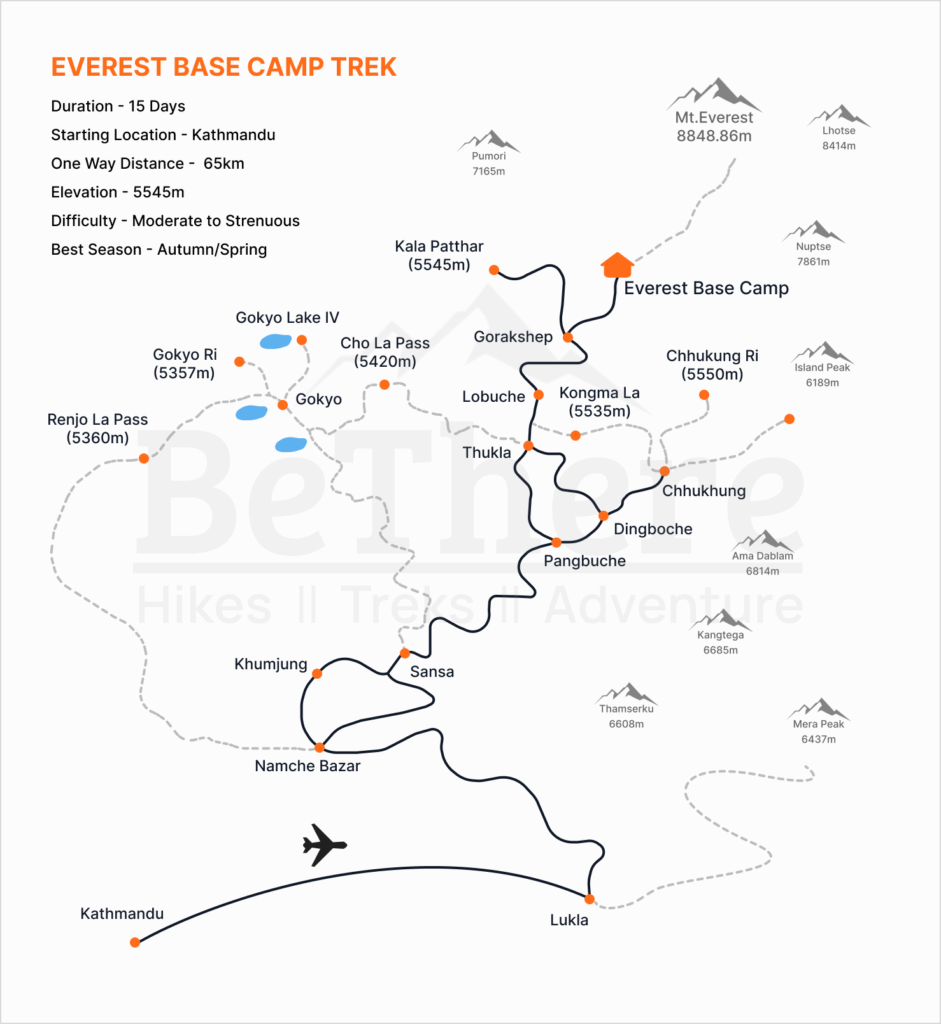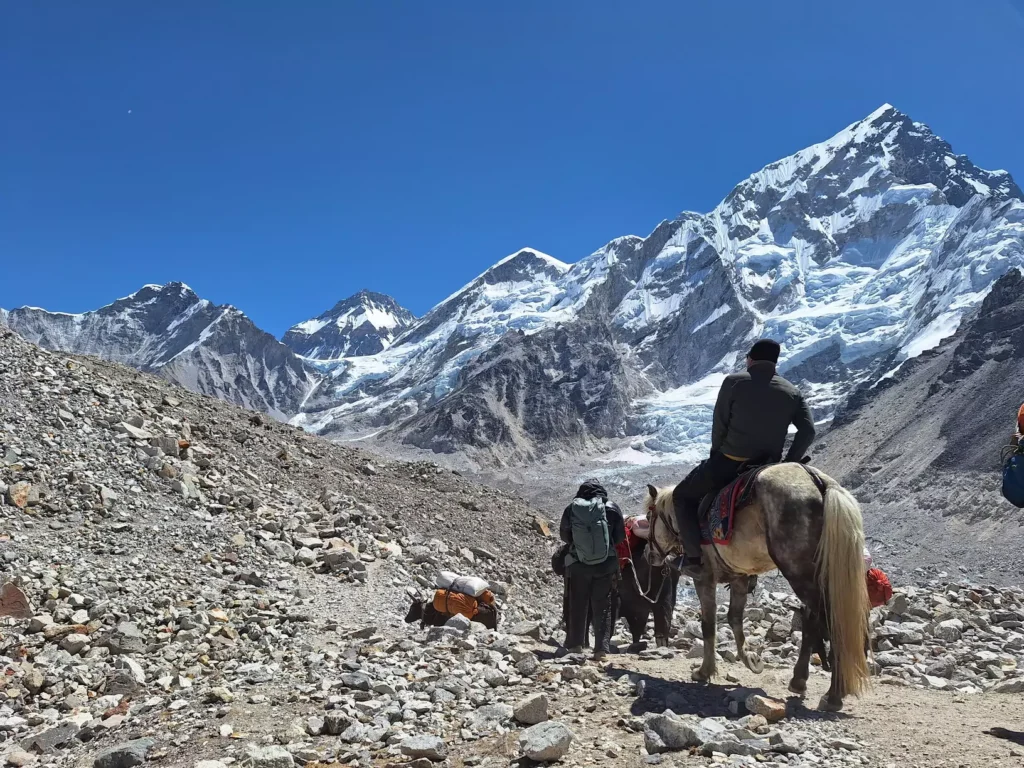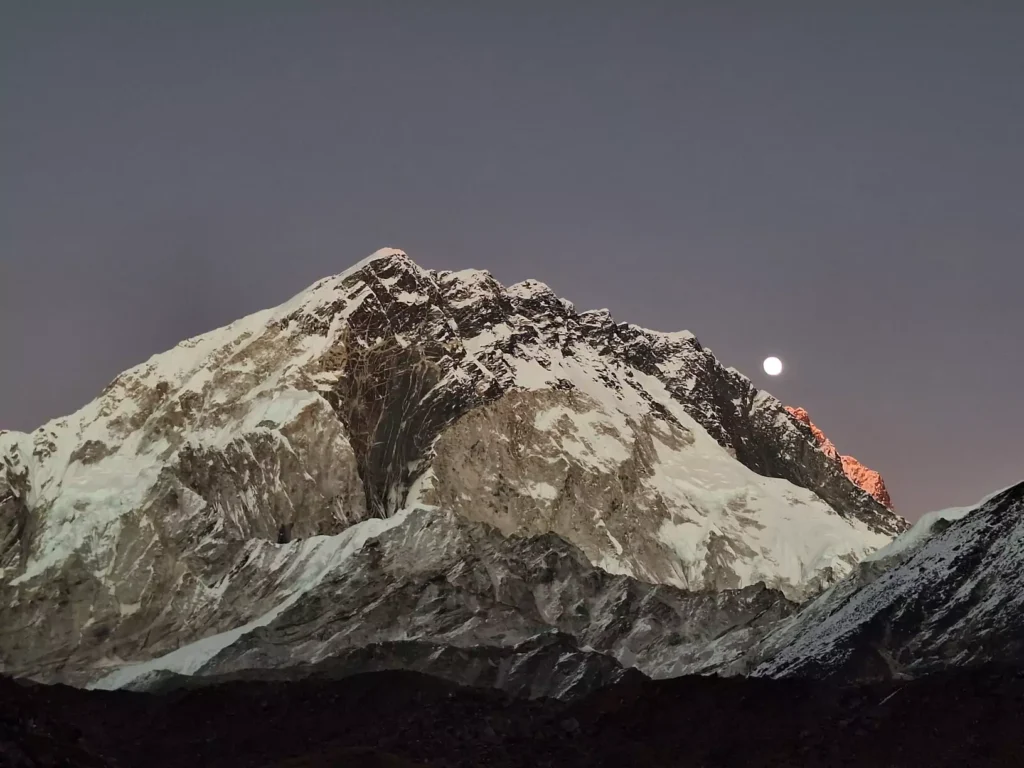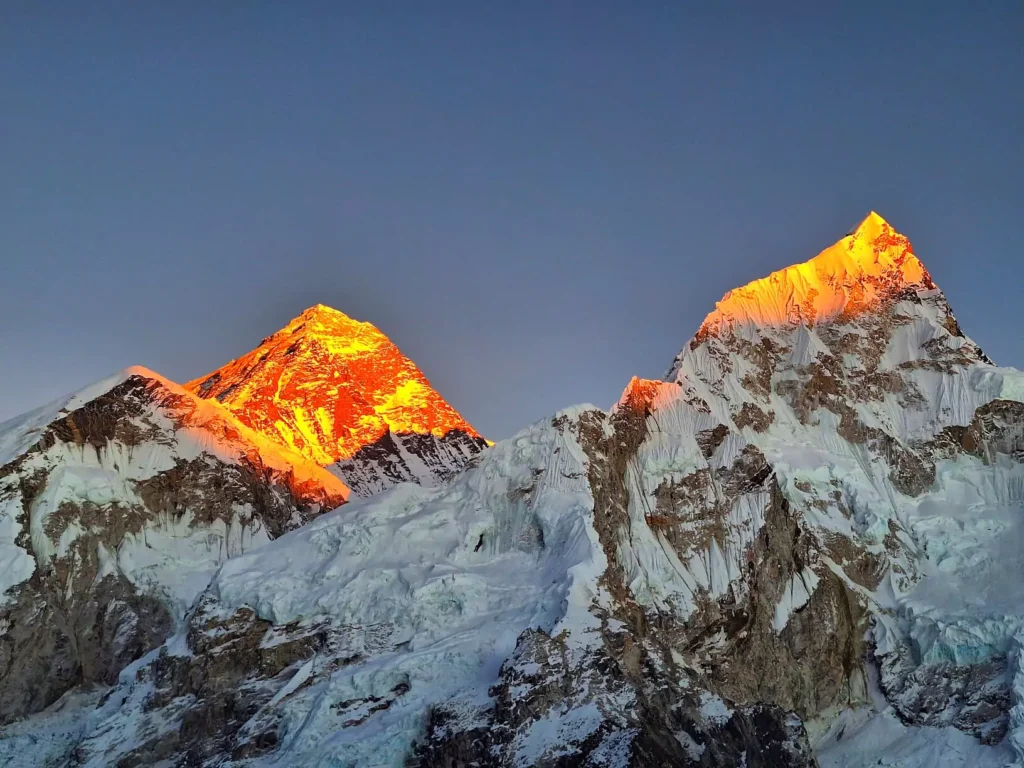Duration
15 Days
Max. Altitude
5545m
Difficulty Level
Moderate to Strenuous
One Way Distance
65Km
Start/End Point
Kathmandu
Best Season
Autumn/Spring
Duration
15 Days
Max. Altitude
5545m
Difficulty Level
Moderate to Strenuous
One Way Distance
65Km
Start/End Point
Kathmandu
Best Season
Autumn/Spring
Everest Base Camp Overview
The Everest Base Camp Trek is one of the most unforgettable adventures on Earth. For many travellers, it’s the closest they’ll ever get to the world’s highest mountain and that makes it truly special.
This legendary trail leads you deep into the heart of the Himalayas. Over 15 days, you’ll follow winding paths through mountain villages, quiet forests, and high alpine valleys until you reach base camp at an altitude of 5,364 meters. Standing there, with Everest towering above you, is a feeling hard to describe.
The Everest Base Camp Trek is not just about reaching a destination. It’s about the journey. It’s about sipping tea in a cosy teahouse after a long day of walking. It’s about crossing swinging bridges over glacial rivers and hearing the sound of prayer flags fluttering in the wind. It’s about meeting people who live in the mountains and learning about their traditions and way of life.
Your adventure begins with a short flight to Lukla, one of the most thrilling airstrips in the world. From there, the trail takes you through places like Namche Bazaar, Tengboche, and Dingboche, each offering a unique view of the mountains and local culture. You’ll also have time to rest and acclimatize so that your body adjusts well to the altitude.
Though the journey can be physically demanding, it’s very achievable with the right mindset and support. You don’t need to be an athlete. What you need is a good level of fitness, a sense of adventure, and a willingness to take it one step at a time.
EBC Trek Highlights
- Reach Everest Base Camp at 5,364 meters and see the legendary Khumbu Icefall
- Watch the sunrise over Everest from Kala Patthar at 5,545 meters
- Fly into the dramatic mountain airstrip at Lukla
- Spend time in Namche Bazaar, the Sherpa capital of the Khumbu region
- Visit Tengboche Monastery with its stunning backdrop of Ama Dablam
- Explore traditional Sherpa villages, yak pastures, and high alpine terrain
- Cross iconic suspension bridges and trek through rhododendron forests
- Acclimatize at scenic spots like Dingboche and climb Nagarjun Hill
- Stay in cosy teahouses and enjoy hearty Nepali meals
- Experience genuine local hospitality and mountain culture with expert guides
Trek Itinerary & Route Map
Day 01Arrival In Kathmandu
Welcome to Nepal! Once you land at Tribhuvan International Airport, our team will greet you and take you to your hotel. Kathmandu, the buzzing capital city, is a blend of ancient temples, vibrant streets, and warm hospitality. You’ll have time to settle in, rest, or explore the colourful lanes of Thamel. In the evening, we’ll have a welcome meeting where your guide will brief you on the trek ahead.
Day 02Preparation Day In Kathmandu
Your adventure begins with a scenic 30-minute flight to Lukla, an airstrip perched between cliffs and mountains. The views from the plane are stunning and the landing at Lukla airport itself is unforgettable.
After landing, we begin our trek. Today’s walk is short and gentle, descending through pine forests and passing traditional stone houses. We follow the Dudh Koshi River to the quiet village of Phakding. It’s a short hike designed to ease you into the rhythm of the trail.
Day 03Fly To Lukla (2,840m) And Trek To Phakding (2,610m)
Your adventure begins with a scenic 30-minute flight to Lukla, an airstrip perched between cliffs and mountains. The views from the plane are stunning and the landing at Lukla airport itself is unforgettable.
After landing, we begin our trek. Today’s walk is short and gentle, descending through pine forests and passing traditional stone houses. We follow the Dudh Koshi River to the quiet village of Phakding. It’s a short hike designed to ease you into the rhythm of the trail.
Day 04Trek From Phakding (2,610m) To Namche (3,440m)
We stay an extra day here at Namce Bazaar to let your body adjust. You can take a short hike to the Everest View Hotel or visit the Sherpa Cultural Museum. The trail to Khumjung village offers great views and insights into local life. These gentle hikes improve acclimatization while letting you soak in mountain vistas. The views of Everest, Lhotse, and Ama Dablam from this place are beyond breathtaking.
Day 05Acclimatize Day In Namche (3,440m)
We stay an extra day here at Namce Bazaar to let your body adjust. You can take a short hike to the Everest View Hotel or visit the Sherpa Cultural Museum. The trail to Khumjung village offers great views and insights into local life. These gentle hikes improve acclimatization while letting you soak in mountain vistas. The views of Everest, Lhotse, and Ama Dablam from this place are beyond breathtaking.
Day 06Trek From Namche To Debuche (3,820m) Via Tengbouche Monastery
Today, we leave Namche and follow a scenic trail carved into the side of the valley. We follow the trail high above the Dudh Koshi river. After lunch at Phunki Tenga, we begin a steady climb to Tengboche, a spiritual center of the region.
Here lies the famous Tengboche Monastery, surrounded by towering peaks like Ama Dablam. The monastery here is the most important in the region. After visiting the monastery, we descend a little further to the quieter village of Debuche for the night.
Day 07Trek From Debuche To Dingbouche (4,410m)
Today, we pass through forests and small settlements. We visit Pangboche, the highest permanent Sherpa village. Then we follow a gradual trail into the open valley of Dingboche.
At this elevation, the air feels thinner, but the views become wider. Dingboche is a beautiful spot nestled among snow-covered hills, and its wide valley offers a great place to rest and prepare for the upcoming high-altitude days.
Day 08Acclimatize Day In Dingbouche; Optional Hike To Nagarjun Hill
Today we rest and acclimatize at Dingbouche. We will stay another night here to give our bodies time to adapt. For those feeling strong, we offer a challenging hike up Nagarjun Hill. It’s steep, but the effort is worth it, with views of Makalu, Lhotse, and Island Peak that are simply stunning. After the hike, we return to Dingboche to rest and refuel our energy.
Day 09Trek From Dingbouche To Labouche Via Thukla Memorial Pass (4,940m)
The trail begins gently, then climbs steeply to Thukla Pass. Here, we stop at a sobering memorial site honouring climbers who lost their lives on Everest. It’s a powerful reminder of the mountain’s legacy.
After this emotional point, we continue on a rocky path to Lobuche, where we rest for the big day ahead. It’s cold and high, but anticipation builds for the journey’s climax.
Day 10Early Morning Trek From Labouche To Gorakshep To Everest Basecamp (5,364m); Overstay Night In Gorakshep
This is the big day. We start early and reach Gorakshep by midday. After a quick break, we continue to Everest Base Camp. The trail is rocky and follows the edge of the Khumbu Glacier. Soon, the famous yellow tents come into view, and the sense of achievement kicks in.
You’re standing at the base of the tallest mountain in the world. You’ll take photos, celebrate with your group, and soak in the energy of this sacred place. Then we return to Gorakshep for the night.
Day 11Early Morning Hike To Kalapathar And Trek To Pheriche (4,240m)
We rise early for the steep climb to Kala Patthar. From here, the view of Everest is at its best, especially at sunrise. It’s one of the most breathtaking scenes you’ll ever witness.
After taking it all in, we descend all the way to Pheriche. The air starts to feel warmer again and the pace downhill eases.
Day 12Trek From Pheriche To Namche (3,440m)
Today, we continue heading down through Pangboche and Tengboche. The trail is familiar now, and it’s satisfying to see how far you’ve come. After lunch, we arrive in Namche, where you can enjoy a hot shower and a good meal.
Day 13Trek From Namche To Lukla (2,840m)
For our descent to Lukla, we follow the trail of Dudh Koshi River back to Lukla that we climbed earlier on our way up. It’s our final day of trekking. You’ll celebrate with your guide and porter and enjoy your last evening in the mountains.
Day 14Fly Back To Kathmandu And Free Day
Today marks your return from the mountains to the bustling capital city. After an early breakfast, we take an early flight back to Kathmandu. After arriving, you can relax, shop for souvenirs, or enjoy a good meal in the city.
After days of physical effort and high altitude, this day is all about rest and reflection. You can choose to take it easy and unwind at your hotel or venture out to enjoy the charm of the city.
Many trekkers love to stroll through Thamel, a colourful neighbourhood filled with shops, cafés, and cultural treasures. It’s a great place to pick up handcrafted souvenirs, prayer flags, or warm pashmina scarves. You can also treat yourself to a relaxing massage, enjoy live music in a rooftop bar, or dine in one of the many restaurants offering both local and international cuisine.
Day 15Final Departure
We’ll drop you at the airport for your flight home based on your flight schedule. You leave with stories, memories, and a deep connection to the mountains.
Your Everest Base Camp journey doesn’t end when you leave Nepal, it becomes part of your story. Something you carry with you. Something you’ll remember every time you look at a mountain and smile.

Includes/Excludes for Everest Base Camp Trek
- Domestic flights (Kathmandu–Lukla–Kathmandu)
- Licensed guide and porter support
- Accommodation during the trek (teahouses)
- All meals during the trek (breakfast, lunch, dinner)
- Trekking permits (TIMS, Sagarmatha National Park, Local entry)
- First aid kit and emergency support
- Airport pickup and drop-off
- Pre-trek briefing and gear check
- International flights to and from Nepal
- Nepal visa fees
- Travel insurance (mandatory with evacuation coverage)
- Personal trekking gear
- Extra snacks, drinks, or desserts
- Hot showers and charging fees at teahouses
- Tips for the guide and the porter
- Extra nights in Kathmandu or Lukla due to flight delays
Note
Please note that due to ongoing road construction along the Prithvi Highway, the drive from Kathmandu to Pokhara has become more time-consuming and dusty than usual. While this journey typically takes around 6–7 hours, current conditions may extend it to 8–9 hours due to traffic congestion and air pollution. We kindly ask for your patience and understanding during this transitional period.
Gears & Equipment
Item
Quantity
1 set of base/thermal Layer and 1 mid-layer
1
1 Set outer layer
1
1 waterproof jacket and 1 waterproof trousers, or raincoat/punchoo instead.
1
1 pair of lightweight trekking trousers or zip-off pants.
1
2 trekking t-shirts/shirts-merino is ideal
2
Four Season Sleeping bag.
1
Four Season Down Jacket.
1
1 pair liner gloves
1
1 warm wool hat
1
1 sunhat or similar
1
Sleeping bag liner
–
Travel towel
–
Sunscreen
–
Moisturizer
–
Lip Balm
–
Toilet Paper
–
1 rucksack/duffle bag for the porters to carry with your overnight kit
1
1-day pack (approx. 30ltr) with a waterproof cover
1
2 x 1ltr water bottles or CamelBak
2
1 x head torch
1
Water purification tablets
–
1 pair trekking boots (must be worn in)
1
Sandals or hut shoes
–
3 pairs thick walking socks / 3 pairs lighter walking socks
3
Running Shoes or sneakers.
1
Power bank
–
Thermal Flask
–
Adaptors: Nepal uses Type D, C and M
–
Food and Accommodation
On the trail, meals are prepared fresh using local ingredients. Typical breakfast options include pancakes, porridge, or muesli, Toast with jam, eggs, or Tibetan bread with Tea, coffee, or hot lemon. Lunch and dinner choices include Dal Bhat, the go-to energy meal for local people, noodles, fried rice, momo (local dumplings), pasta, potato dishes, soups and steamed or fried vegetables.
As you gain altitude, the food menu becomes more limited, but it still provides enough energy to keep you going. It’s best to avoid meat at higher elevations since it’s not always fresh. Vegetarian meals are safe, nutritious, and widely available.
During the trek, you’ll stay in teahouses, local guesthouses built by mountain families. These are warm and welcoming places, though simple. Rooms usually come with two beds and a small table. Most teahouses offer shared bathrooms and hot showers for a small fee. In the evenings, the common dining hall becomes the heart of the place, often heated by a yak-dung stove. This is where you’ll gather with fellow trekkers, sip tea, and share stories from the trail.
As you climb higher, the teahouses become more basic, but they remain clean and cosy. Blankets are usually provided, but you may still need a good-quality sleeping bag to stay warm at night.
FAQs
How difficult is the Everest Base Camp Trek?
The Everest Base Camp Trek is moderately challenging but achievable for anyone with a decent fitness level and strong determination. You’ll be walking 5–7 hours a day on uneven trails, often at high altitude. You don’t need prior trekking experience, just the willingness to keep going one step at a time.
What is the best time to trek to Everest Base Camp?
The best seasons for Everest Base Camp Trek are spring (March to May) and autumn (September to November). These months offer clear skies, great views, and stable weather. Winter is extremely cold and summer brings monsoon rains, which can make trails slippery.
What permits do I need for the Everest Base Camp trek?
You’ll need a TIMS card, Sagarmatha National Park permit, and a local entry permit to trek the Everest Base Camp region. Don’t worry, our team handles all the paperwork for you before the trek begins.
What happens if my flight to or from Lukla is delayed?
Weather conditions can delay flights to and from Lukla, especially during peak or monsoon seasons. While we plan your trek carefully, we recommend allowing 1–2 extra days at the end of your trip just in case. Our team helps rearrange flights and accommodation if delays occur.
What is the highest point of the Everest Base Camp Trek?
The highest the trek is the Everest Base Camp (~5,364 m / 17,600 ft), with acclimatization stops in places like Dingboche and Gorak Shep. Altitude sickness is a serious risk, so you must be fully aware of symptoms like headache, nausea, fatigue and allow yourself extra rest days to acclimatize properly.
Do I need to be very fit to do this trek?
You don’t need to be very fit to do this trek, but a good level of fitness is important. We recommend preparing at least 6–8 weeks in advance by doing cardio exercises like hiking, running, cycling, or swimming. Strength training and walking with a backpack can also help.
Is altitude sickness a risk, and how is it handled?
Yes, altitude sickness is a concern. That’s why we follow a gradual ascent plan with two acclimatization days built into the itinerary. Your guide is trained in altitude awareness and first aid. They monitor your health daily and know what to do in case of symptoms. Helicopter evacuation is available in emergencies.
Need help with your trek?
Reach out to our travel experts
Starts at
USD $1550 $1300 / Minimum 2 Pax
Plan Your Hike

Nepal🇳🇵
What Trekkers are Saying About Us
Bhasmasur Hill was challenging but rewarding with its stunning views. Subash Ghimire’s tips about local culture and nature brought the hike to life for me. It felt like a real adventure, and his friendly attitude kept the group motivated.

Timo Janssen
Traveler from Netherlands
Shivapuri Peak was a perfect challenge for me, tough enough to feel like an accomplishment, but the views were worth every step. The whole experience was seamless thanks to BeThere. They took care of all the planning, so I could just enjoy the hike and nature.

Hannah Brooks
Traveler from USA
Bishnudwar was a quiet, beautiful hike, just what I needed to get away from the daily grind. Alexander Lama knew all the best spots for photos and even pointed out some wildlife. I couldn’t have asked for a better guide.

Nathan James
Traveler from New Zealand
The trail to Nagi Gumba was peaceful and absolutely stunning. BeThere fun made the trip feel so organized and stress-free, from start to finish. I loved being surrounded by nature, just a short drive from Kathmandu.

Rachel Bennett
Traveler from UK
Nagarkot was everything I hoped for beautiful forest trails, fresh air, and incredible valley views. The trip was well arranged by BeThere, which allowed me to relax and focus on the experience without any worries.

Felix Schmidt
Traveler from Germany
Lobuche Peak was intense but rewarding. Subash Ghimire made sure we were ready for the climb and kept spirits high with his friendly attitude. This was one of my favorite trekking experiences by far.

Giulia Bianchi
Traveler from Italy
Need help choosing a trail?
Connect with a local and plan your perfect trek.


